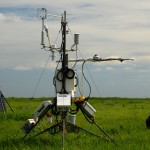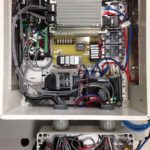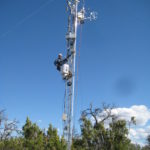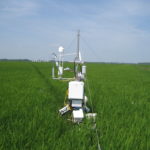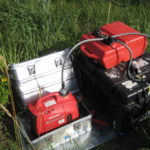AmeriFlux Portable Eddy Covariance System (PECS) – Parts list and components
- AmeriFlux Portable Eddy Covariance Sytem (PECS)
- photo of PECS interior with panel removed
- PECS installed at US-Mpj during 2016 site visit
- PECS with methane sensor during site visit at US-HRA
- PECS during site visit at US-KON
- Gasoline generator system available to power PECS
The AmeriFlux Tech Team deploys a Portable Eddy Covariance System (PECS) during site visits to conduct side-by-side evaluations of eddy covariance, meteorological, and radiation measurements. The PECS has changed over time and continues to evolve. The AmeriFlux Tech Team is currently using the 5th generation PECS which was originally designed and built by Dave Billesbach (University of Nebraska, Lincoln). The team has two PECS which allows simultaneous deployments. The Tech Team has two PECS which allows simultaneous deployments.This page describes the current PECS components, sensors, and software.
- Data acquisition main enclosure (image)
- Enclosures
- 16×18” fiberglass main unit houses CPU, communication, logger, electronics (Stalin, model J1816HPL)
- 8×12” plastic enclosure is the interface for all data/power cables (Bud, model NBD-15442)
- CPU
- Compact, fanless computer (Logic Supply, model POC-210)
- 4 COM ports, 2 network ports
- Windows-7 operating system
- Monitor (GeChic On-lap, model 1302)
- Keyboard/mouse (Adesso, model ACK-540PB)
- Datalogger/multiplexer
- Datalogger (Campbell Scientific, model CR1000)
- Multiplexer (Campbell Scientific, model AMT25)
- Ethernet interface (Campbell Scientific, model NL120)
- Networking
- Cellular communications
- Cellular modem (Sierra wireless, model GX440)
- Multi-band, omnidirectional antenna (Laird, model OC69271-FN)
- 4-port, unmanaged network switch (D-link, model unknown)
- Cellular communications
- Data communications
- RS-422 to RS-232 bidirectional converter (Blackbox, model IC1470A-F)
- Used for communications with Gill R3-50
- RS-232 to Ethernet converter (Sena, model LS100)
- Used for serial communications to LI-7700
- RS-422 to RS-232 bidirectional converter (Blackbox, model IC1470A-F)
- Power modulation
- DC to DC converter, 5 VDC output (V-Infinitiy, model VAWQ3-Q24-S5H)
- Controls
- Solid state relays (Crydom, model DC60S3)
- Manual switches
- Connectors
- 4 pin (Amphenol, models: 206060-1, 206061-1, 206429-1, 206430-1)
- 9 pin (Amphenol, models: 206705-1, 206708-1)
- 16 pin (Amphenol, models: 206036-1, 206037-1)
- Enclosures
- Sensors
- Sonic anemometer
- Three dimensional, non-orthogonal (Gill, model R3-50)
- Gas analyzers
- Open-path, infrared analyzer for CO2 and H2O (LI-COR, model 7500A)
- Enclosed-path, infrared gas analyzer for CO2 and H2O (LI-COR, model 7200)
- Open-path, wavelength modulation spectrometer for CH4 (LI-COR, model 7700, optional)
- Air temperature
- Resistance temperature device (R.M. Young, model 43347)
- Fan aspirated shield (R.M. Young, model 43502)
- Platinum resistance thermometer (Vaisala, model HMP155a)
- 14-plate radiation shield (R.M. Young, model 41005-5)
- Resistance temperature device (R.M. Young, model 43347)
- Relative humidity
- Vaisala, model HMP155a
- 14-plate radiation shield (R.M. Young, model 41005-5)
- Vaisala, model HMP155a
- Barometer
- Vaisala, model PTB110
- Four-component net radiation
- Kipp & Zonen, model CNR4
- Includes heater/ventilator unit
- Sunshine pyranometer (total/diffuse solar radiation)
- Delta-T, model SPN1
- Photosynthetically active radiation
- Kipp & Zonen, model PQS1
- Leaf wetness sensor
- Decagon, model LWS
- Sonic anemometer
- Hardware
- U-bolts
- Stainless steel, 5/16”-18 thread
- Various diameters: 1.375”, 1.5”, 1.75”, 2.0”, 2.5”
- Booms
- 1” aluminum tube (general purpose), lengths: 0.5’, 1’, 1.5’, 3’
- 5’x1.25”x1.25” square aluminum boom for radiation sensors (custom)
- Tube fittings
- Aluminum slip on fittings for 1” pipe (NuRail, models 8757, 8777)
- Mounting plates
- 6”x4”x0.5” aluminum plate (custom) (image)
- 12”x6”x2” aluminium plate for radiation boom (custom) (image)
- U-bolts
- Power options
- Line power
- AC-DC power converter 150 W (Triad Magnetics, model AWSP150-12)
- Enclosure (HI-BOX, model EN-000-2030)
- Connectors (Amphenol, model 206430-1)
- Used for sites with available line power
- Gasoline generator
- 1000W Gas generator (Honda, model EU 1000i)
- External tank (Moeller, model 620049LP)
- Fuel line (Moeller, model 034391-10LPA)
- Aluminium Enclosure (Zarges, models 40500, 40502)
- Used for sites without available power
- Solar panels
- 150W solar panels, up to 6 (SolarWorld, model SW 150 Poly R6A)
- 12V, 100Ah batteries, up to 8 (Exide, model Sunlyte 12-5000X)
- Charge/load controllers (Morningstar, models Tristar TS-60, TS-45)
- PV combiner (Midnite Solar, model MNPV6)
- Miscellaneous breakers, bus bars, enclosures, wire
- Line power
- Optional components
- Methane analyzer (LI-COR, model 7700)
- Tripod (Campbell Scientific, model CM115)
- Software
- High frequency data acquisition with HuskerFlux
- Custom, Fortran-based program written and developed by Dave Billesbach
- Source code and executable available
- Slow frequency data acquisition and management with Loggernet (Campbell Scientific)
- Automated data retrieval
- Custom scripts for data management
- Daily data transfers and archival to server
- 30 minute ‘quick look’ file transfers for near realtime data visualization
- Visualization via dygraphs
- Eddy covariance flux processing
- EddyPro (LI-COR)
- High frequency data acquisition with HuskerFlux

